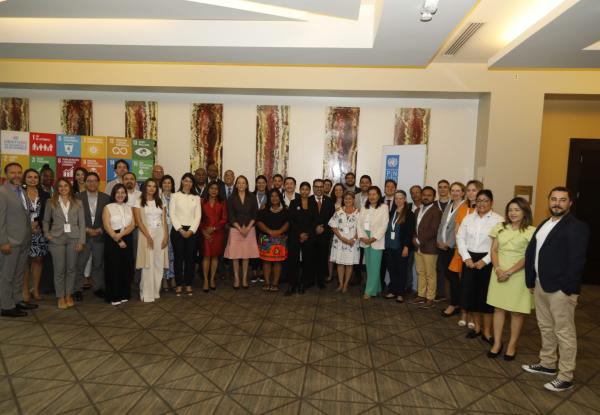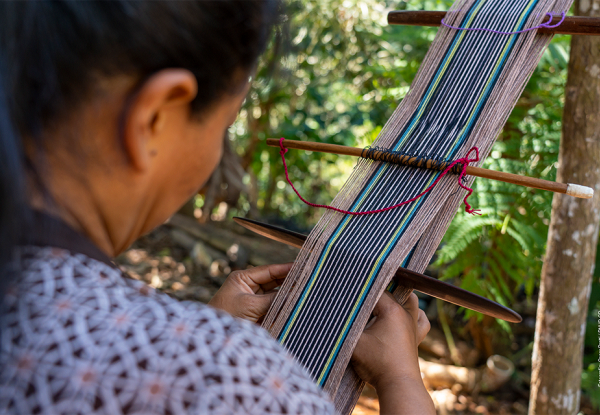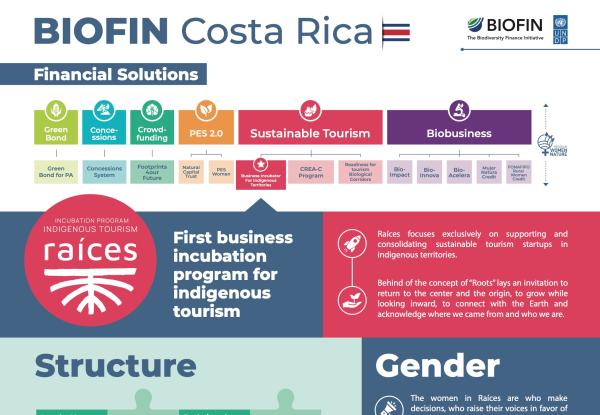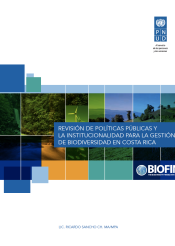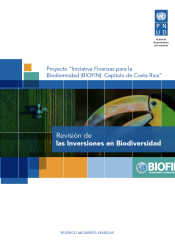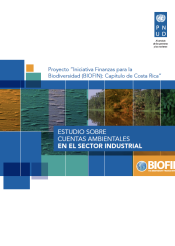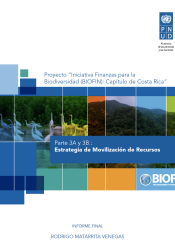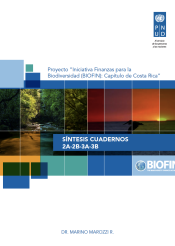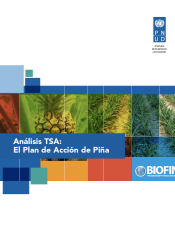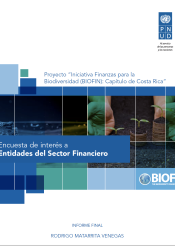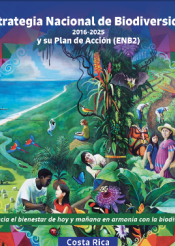Costa Rica
Costa Rica is located in a privileged territory between the Nearctic and Neotropical bioregions and holds diverse microclimates and ecosystems that shelter between 5-6% of world known species that are part of the natural capital of the country. Costa Rica’s nature-based tourism model has proven itself as one of the most important ecotourism destinations of the world, which represented 8.2% of GDP for 2016 for direct and indirect economic activities (CBCR and ICT, 2018).
This small Country in Central America is model for its restoration of forest cover, winning Earth Champion prizes that ecognize its National Conservation Area System that covers 26% of the country’s terrestrial area and 2.6% marine ecosystems as well as its Payment for Ecosystem Services Program. Furthermore, its Decarbonization plan for 2050 was one of the first and this recognized leadership in climate action is also consistent with its co-leadership of the High Ambition Coalition for 30x30 goals to protect nature.
BIOFIN Costa Rica has supported the understanding of both the value of natural assets and investment in nature itself. The report prepared by BIOFIN estimates that the total annual value of Costa Rica's natural capital is $ 14.5 billion, according to the information available for the evaluated ecosystems, which represent 23% of the country's GDP for the year 2019.
This shows the significant contribution of nature to the local economy and human well-being, and the significant impact that the potential loss and degradation of ecosystems represents to the Country’s wellbeing.
BIOFIN has updated biodiversity expenditure review for 2015-20 and relevant findings indicate that Central Government represented 0.18% of GDP, while in deconcentrated and decentralized entities, the annual average corresponds to 0.63% of GDP. This considers the public investments made from different sectors that favor the conservation and sustainable use of biodiversity. A first estimation of the biodiversity financial gap presented an optimistic scenario at 0.07% of GDP, 0.2% in a modest scenario and 1.2% in a critical scenario that unfortunately might be closer to a post pandemic estimation, and perhaps even closer or when adjusting to higher ambition goals, for example to increase 30% of marine ecosystem conservation.
Starting in 2018, in its second stage, BIOFIN Costa Rica implements a portfolio of 6 Financial Solutions (FS) to meet and reduce the financial gap for nature, with a clear consideration to include women, indigenous territories and rural communities as frontline champions that catalyze a new economy with nature considerations at its core.
In Costa Rica, BIOFIN has already mobilized and contributed to catalyze USD$ 84.9 million, under 6 financial solutions and a novel +Women+Nature Program, including:
- A new generation of Payment for Ecosystem Services.
- A Thematic Bond for Protected Areas.
- A Concessions Platform for increased revenue for the PA system and business opportunities for communities.
- Crowdfunding initiative campaign #HuellaDelFuturo to restore nature and promote green wages especially for rural women in Northern Costa Rica.
- Seed capital and entrepreneurship for sustainable tourism in biological corridors and indigenous territories.
- A bio business financial platform that develops pipeline and financial mechanisms to promote nature positive investments.
1. Thematic Bond for Protected Areas
The main purpose of this financial solution is to develop conditions to establish and issue a green or sustainable bond from the securitization of future income from the National Protected Areas System (SINAC) in order to invest in infrastructure development in Protected Areas. Infrastructure development will improve SINAC's quality and diversification of tourist services, which in turn will allow a greater possibility of contracting concessions of non-essential services and improve income and financial sustainability for SINAC.
2. Concessions Platform for Protected Areas
This financial solution aims at the establishment of a system of concessions of Non-Essential Services in Protected Areas and in tourist landscapes (biological corridors, PA buffer areas) as a mechanism to increase revenues for protected areas, including SINAC and for local communities to achieve more inclusive and equitable development. The concessions represent public-private partnerships (PPPs) that can increase employment, reduce wildlife poaching, and prevent the depletion of cultural and natural capital.
3. Crowdfunding Huella del Futuro
The Huella del Futuro initiative seeks to bring together partners from various fields with a view to rebuild a greener, more supportive, inclusive, and sustainable future in Costa Rica. Under this initiative Costa Rica team launched the crowdfunding mechanism and campaign “FootPrints4ourFuture- Huella Del Futuro” Targeting private and public companies, financial institutions, bilateral cooperation, and individual donors to provide economic relief while contributing to ecosystem restoration, creating jobs, especially for women, for planting and providing maintenance for 200,000 trees for at least 5 years.
4. New generation of Payment for Ecosystem Services Program (PSA 2.0)
The main objective of this financial solution is to internalize the value of ecosystem services through the economic return to those who maintain the ecosystem through sustainable activities and to identify the source (s) of funds that would gradually replace the income of the tax on fossil fuels that is intended to be reduced in Costa Rica's carbon neutrality goal by 2030. A model of a nextgen PES conceptualized as the first Natural Capital Trust, intends to extend and replicate successful PES model to other ecosystem services beyond public forests to marine, wetlands, and other services such as pollination. A compensation scheme is also addressed within the model. UNDP CO also achieved a high mobilization of resources for REDD+ through a Payment for Results modality of the GCF.
5. Seed Capital and Entrepreneurship for Sustainable Tourism
Development of financial mechanisms to increase employment, promote resilience through COVID19 pandemic, reduce poaching of wildlife, prevent the loss of cultural and natural capital and achieve more inclusive and equitable development for communities, especially for women and indigenous people through sustainable tourism in rural communities. A paradigm shift is supported through financial mechanisms that seek to strengthen rural communities and indigenous groups from grantpeneurs to entrepreneurs in alliance with the Sustainable Bank System in Costa Rica.
6. Biobusiness Platform
The Bio-business Development of a business portfolio with emphasis on bioeconomy for the mobilization of impact investment funds and financing through preferential green credits, with the aim of promoting companies that make sustainable use of biodiversity or whose business model seeks to mitigate, reduce or eliminate the negative impacts of human activities on ecosystems.
The study on the institutional framework of Biodiversity in Costa Rica identified a total of 190 policies and practices, as well as a total of 131 institutional actors that directly affect 14 sectors of Biodiversity (Agriculture, Forestry, Aquaculture and Fisheries, Mining, Water Management, Waste Management, Tourism, Energy, Transport and Infrastructure, Industrial Production, Conservation, Territorial Planning, Climate and Financial Change).
Some relevant findings on the current institutional framework point to the lack of inter-institutional coordination, scarce assurance of resources and economic valuation for policy execution, and the limited participation of private sector stakeholders in the design and implementation of policies, among others.
The first phase identified in the development of the country's institutional framework on biodiversity, begins with the policies for the creation of national parks, biological reserves and conservation areas that initiated in the early 1970s and concluded in the early 1990s, when about one third of the continental territory of Costa Rica was made up of national parks and reserves. The report refers to this as the "conservationist" phase due to the protective territorial approach that prevailed during its development.
The second phase was developed from the early 1990s with the establishment of a legal framework led by Wildlife Conservation Law No. 7317 of 1992; Organic Law of the Environment No. 7554, passed in 1995; Forestry Law of Costa Rica No. 7575, passed in 1996; Biodiversity Law passed in 1998, and the provisions that led to setting the conditions that would later result in the first National Biodiversity Strategy developed in 1998 (2000-2005), together with further efforts to strengthen the conservationist phase, a series of enhanced environmental management instruments extended to strategic sectors such as water, energy and transport, and under the auspices of important international conventions signed and ratified by Costa Rica. This management phase, lasting about twenty years, has been identified as "institutional" due to the high number of legal instruments that were established for biodiversity management.
The third phase, which we will describe here as the "ecosystemic" one, currently has an incipient development and constitutes a transition from the need to mainstream an integrating vision of the ecosystems, which begins to characterize the current strategies. Both the international and national public opinion call to enhance coordination amongst all sectoral efforts in favor of Biodiversity. This transition is reflected in several recent proposals, and it should consider economic valuation and sustainable use as a result of two major transformations: the first one from the national agricultural production matrix to technology, tourism and service sectors; the second one is characterized by the mobilization of new economic, social and political factors in the face of climate change, which will imply a more active participation of communities and individuals, as well as the articulation of all sectors of the Costa Rican society with respect to Biodiversity.
From the point of view of finances for biodiversity in Costa Rica, environmental expenditure has been distinguished as a mobilization of public and private financial resources allocated to environmental matters as a whole.
Traditionally, the expenditure allocated to biodiversity had been valued only in terms of the resources allocated to those entities whose primary function originated in the protection of biodiversity, as is the case of the National Commission for the Management of Biodiversity (CONAGEBIO) and the National System of Conservation Areas (SINAC).
As part of the contribution of the BIOFIN initiative, it was possible to evolve towards the identification of a "hard core institutionality" of biodiversity, which encompasses a wider universe of institutions relating to the management and use of biodiversity directly, according to the definition of Rio Markers.
Based on this new methodology, it is possible to identify that the expenditure on biodiversity made by Costa Rica for 2014 amounts to a value of about US $ 247.4 million, equivalent to 0.5% of GDP.
Of the four sectors comprising the twelve institutions linked to biodiversity management and use, the agricultural sector absorbs 48.4% of the allocated resources, followed by the conservation sector with 30.6%, the forestry sector with a 29.3%, and the aquaculture and fisheries sector with 1.7% of the total investment in biodiversity.
In an effort supported by the BIOFIN program, it was possible to update the National Biodiversity Strategy 2016-2025, Costa Rica, which establishes a roadmap for the actions needed to attain the national biodiversity objectives, with a special emphasis on the challenges that the country is facing in this area.
As part of this strategy, the main national tools are proposed to achieve adequate protection of the natural heritage, to maintain adequate levels of health and resilience of national ecosystems, and to have the capacity to rehabilitate those biodiversity elements that have already undergone some deterioration.
The National Biodiversity Strategy and its Action Plan 2016-2025 are part of the National Biodiversity Policy of Costa Rica 2015-2030 (NBP) and together constitute the public policy framework for conservation, sustainable use, and equitable distribution of the benefits of the biodiversity of Costa Rica.
The National Biodiversity Strategy of Costa Rica identifies its priorities based on seven strategic issues, 23 global medium-term goals (by 2025), 98 national goals (by 2020) and a portfolio of programs and projects where Costa Rica seeks to propose integrated efforts among government institutions, academia, municipalities and civil society-private sector (with special attention to interest groups such as local communities, indigenous peoples, women and youth) to achieve long-term effects and impacts.
The seven strategic issues raised by this strategy are:
- In Situ Conservation: sustainability, and connectivity-resilience of the National System of Protected Wild Areas.
- Restoration and reduction of the loss and/or deterioration of important elements of biodiversity: terrestrial, marine, fresh water-aquaculture ecosystems, wildlife, genetic resources, adverse impact, and legal compliance.
- Regularization of the State Natural Heritage and territorial and marine space planning.
- Inclusive sustainable landscapes.
- Governance, participation, education and cultural practices for biodiversity.
- Information management, monitoring and research on biodiversity.
- Capacities, finance resources and institutional arrangements for biodiversity.
Although part of the financing needed for the implementation of this strategy is available, there are goals that still require economic resources; and 18 profiles of new programs and projects have been identified that still require the allocation of additional resources. The 18 new profiles for which there is a financing gap are represented by the following programs:
- Profile 1: Consolidation, restoration, connectivity and resilience of the Natural Protected Areas System
- Profile 2: Information, research and monitoring of Biodiversity Program
- Profile 3: Biodiversity and Indigenous Peoples Program
- Profile 4: Forests, Soils and Water: Conservation, restoration and sustainable use of terrestrial ecosystems and their functions in the hydrogeological cycle
- Profile 5: Conservation, restoration and sustainable use of wetlands and marine ecosystems
- Profile 6: Strengthening national capacities for the protection, recovery and management of threatened species and wildlife in Costa Rica
- Profile 7: Biodiversity, food security, agriculture and health
- Profile 8: Strengthening capacities for the management of invasive species
- Profile 9: Sustainable productive practices and biodiversity
- Profile 10: Strengthening protection, prevention and control of fire
- Profile 11: Strengthening capacities for the prevention, protection and monitoring of biodiversity
- Profile 12: Strengthening of Natural Capital of the State regularization processes and land purchase in natural protected areas
- Profile 13: Strengthen ecosystem approach in the planning and implementation of development plans (regulator, rural, management plans) and strategic sectors
- Profile 14: Program for sustainable productive ventures and community-based adaptation (biological corridors, buffer zones, others)
- Profile 15: National Program of Biodiversity Education: Culture for Life
- Profile 16: Strengthening of the various governance models for the conservation and sustainable use of biodiversity
- Profile 17: Traditional knowledge and ABS for genetic and biochemical resources that contributes to the conservation of biodiversity of global importance.
- Profile 18: Strengthening of institutional framework and capacities for Biodiversity management.
The institutions and organizations responsible for these programs must work, with the support of the BIOFIN initiative, to attain the resources needed for the implementation of these programs. The financial needs are estimated to be between US$25 million per year for a low profile scenario and US$50 million per year in the high profile scenario, over a nine years period.
The exercise to identify funding gaps was developed from the formulation of the National Biodiversity Strategy and complemented by BIOFIN as follows:
- during the process of developing the NBSAP in a participatory manner, the measurable, quantifiable and temporally-defined results that could be established as short, medium and long-term goals were identified, based on the axes and guidelines of the National Biodiversity Policy;
- medium-term goals for 5 years or less were discussed, and in turn, budget support was identified through an institutional program, alternative finance source (lending, trust, own income, etc.), or projects contributing to the achievement of the goals and it was quantified for the first years of implementation of the NBSAP;
- goals that did not have enough, regular or temporally defined financing were identified, and a portfolio of programs was proposed to address these gaps;
- BIOFIN quantified estimates of the amounts that could be required for implementation and the estimates to finance those gaps were developed based on such information;
- the search for finance solutions begins from the issues and programs without regular financing and consolidated institutional programs.
In this sense, the Biodiversity Finance Plan aims to identify a portfolio of initiatives, that is, a menu of finance alternatives, with the purpose of evaluating their implementation viability and feasibility, as well as their potential for the generation of finance resources aimed at filling the financing gap for the implementation of the National Biodiversity Strategy.
In this regard, the improvement of efficiency in the use of resources budgeted for the environment and biodiversity is especially relevant, as well as the strengthening of the management and administration of environmental projects funded with public investment.
Part of the evaluated finance alternatives include the analysis of the possible implementation of a prepayment system for entrance fees to national parks, the implementation of management models through public/ private partnerships, the promotion of the financial sector participation in granting loans for environmental projects and projects, the application of cleaner production technologies, the construction and acquisition of environmentally friendly houses, and the purchase of environmentally compatible durable goods, as well as the channeling of resources from international cooperation to the "development axis" called Environment and Territorial Planning, which incorporates specific considerations related to biodiversity and ecosystems elements comprising issues such as: i) environmental quality; ii) water resources; iii) biological diversity; and iv) climate change and agro-environmental management.
The finance plan also analyzes the possibilities of implementing other finance alternatives, such as green investment funds, in which the raised resources would be aimed at acquiring securities (debt or equity) issued by companies with an environmental component in their activities, finance securities with an environmental component such as bonds funding environmental services for carbon fixation or protection of water resources, securities issued by companies with environmental certifications such as carbon neutrality and environmental ISO, among others.
Likewise, the possible securitization of income-generating assets of green projects is evaluated, such as, for example, entrance fees to national parks or income resulting from concessions for the exploitation of biological reserves for tourism purposes, among others.
Therefore, the Biodiversity Finance Plan becomes a very valuable input for the identification of finance solutions that can positively impact the mobilization of the additional finance resources required to achieve the goals proposed by Costa Rica in its National Biodiversity Strategy.
